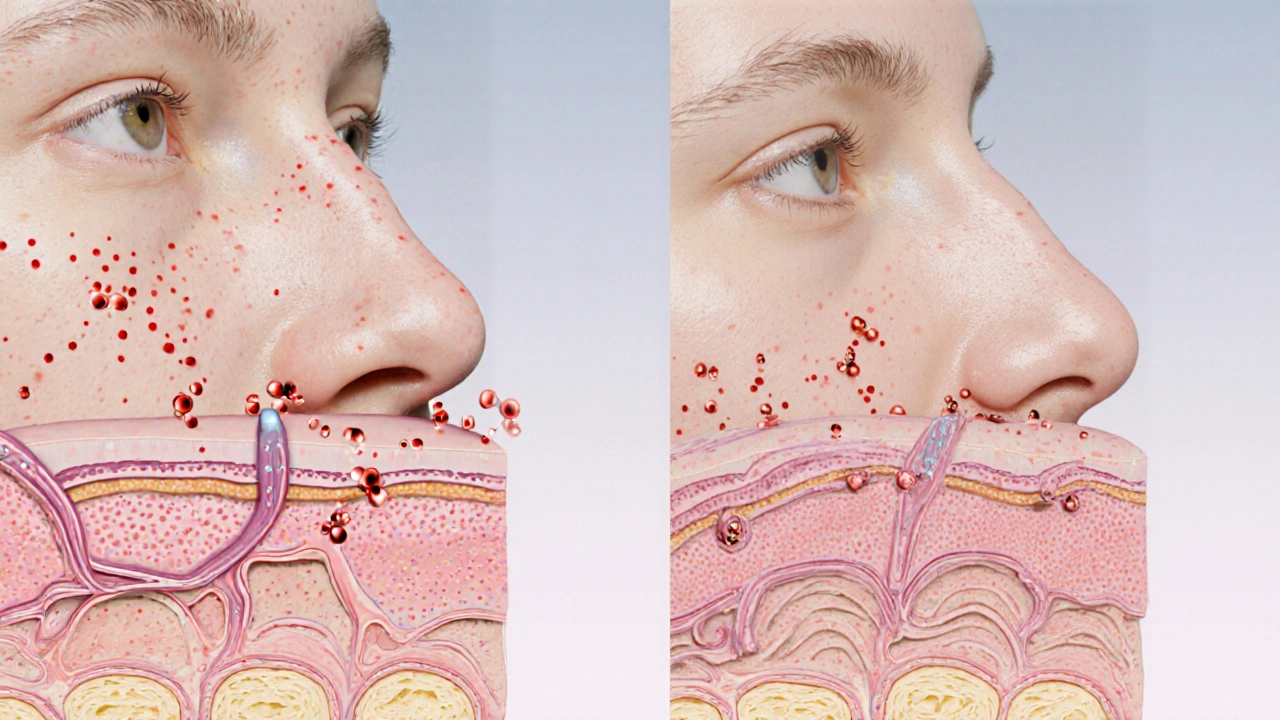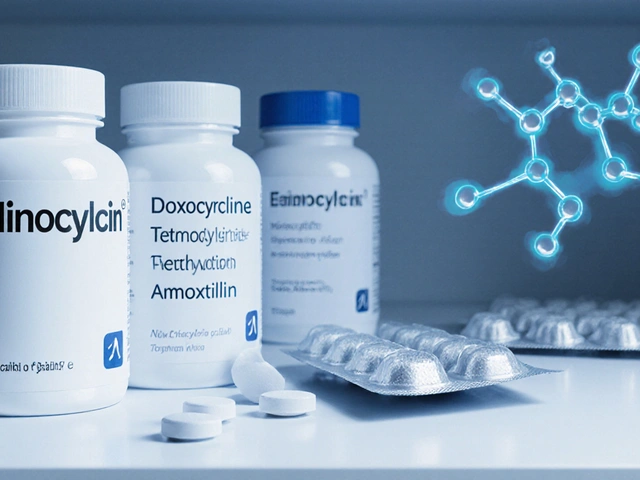Minocin vs. Alternatives: Antibiotic Comparison Tool
This tool helps compare Minocin (minocycline) with its most commonly prescribed alternatives. Select an antibiotic below to see detailed information and how it compares across key categories.
Side Effect Profile
| Category | Minocin | Alternative |
|---|---|---|
| Common GI Effects | ||
| Photosensitivity | ||
| Serious Risks | ||
| Pregnancy Category |
When doctors need a versatile, long‑acting tetracycline, they often reach for Minocin. But with so many antibiotics on the market, how does it really stack up? This guide breaks down Minocin’s strengths and weaknesses, then compares it side‑by‑side with the most common alternatives - doxycycline, tetracycline, tigecycline, azithromycin, clindamycin and amoxicillin. By the end you’ll know which drug fits which infection, what to watch for, and how to talk to your clinician about the right choice.
What Is Minocin (Minocycline)?
Minocin (minocycline) is a semi‑synthetic tetracycline antibiotic that works by blocking bacterial protein synthesis. First approved in the 1970s, it boasts a longer half‑life (≈16‑20hours) than many of its cousins, allowing twice‑daily dosing for most infections. Typical adult dosage for acne or respiratory infections is 100mg once or twice daily, while higher doses (200mg) may be used for severe infections such as meningitis.
Key attributes of Minocin:
- Broad spectrum: effective against Gram‑positive, Gram‑negative, and atypical organisms.
- High tissue penetration, especially in skin and bone.
- Good oral bioavailability (~90%).
Common side effects include dizziness, photosensitivity, and, in rare cases, drug‑induced lupus. Because it can cause permanent tooth discoloration, it’s usually avoided in children under eight.
Major Alternatives to Minocin
Below are the most frequently prescribed alternatives, each with its own niche.
Doxycycline
Doxycycline is another tetracycline derivative, distinguished by a shorter half‑life (≈12hours) and a lower risk of vestibular side effects. It’s often the first‑line choice for Lyme disease, RockyMountainspot fever, and certain sexually transmitted infections.
Tetracycline
Tetracycline is the parent compound of the class. While still effective, it requires multiple daily doses (four times a day) and has a higher incidence of gastrointestinal upset.
Tigecycline
Tigecycline is a glycylcycline, structurally related to tetracyclines but engineered to overcome many resistance mechanisms. It’s given intravenously and reserved for complicated skin and intra‑abdominal infections when other options fail.
Azithromycin
Azithromycin belongs to the macrolide family. Its long half‑life allows once‑daily dosing for up to five days, making it popular for community‑acquired pneumonia and chlamydia. However, it lacks activity against many resistant Gram‑negative organisms.
Clindamycin
Clindamycin is a lincosamide antibiotic effective against anaerobes and certain Staphylococcus aureus strains, including some MRSA. It’s often used in dental infections and postoperative wound care.
Amoxicillin
Amoxicillin is a penicillin‑type beta‑lactam with a broad spectrum against many Gram‑positive organisms and some Gram‑negative bacteria. It’s the go‑to drug for ear, nose, throat infections and uncomplicated urinary tract infections.
Side‑Effect Profiles at a Glance
Understanding tolerability is crucial, especially for long‑term courses such as acne treatment.
| Antibiotic | Common GI Effects | Photosensitivity | Serious Risks | Pregnancy Category (US) |
|---|---|---|---|---|
| Minocin (minocycline) | Mild nausea, occasional vomiting | High | Drug‑induced lupus, vestibular dysfunction | Category D |
| Doxycycline | Rare, mild stomach upset | High | Esophageal irritation, rare hepatotoxicity | Category D |
| Tetracycline | Frequent nausea, diarrhea | High | Tooth discoloration, hepatotoxicity | Category D |
| Tigecycline | Significant nausea, vomiting | Low | Pancreatitis, increased mortality in ventilated patients | Category C |
| Azithromycin | Low incidence | Low | QT prolongation, hepatotoxicity | Category B |
| Clindamycin | Moderate diarrhea, risk of C. difficile colitis | Low | Severe C. difficile infection | Category B |
| Amoxicillin | Low to moderate | Low | Allergic reactions, rare liver injury | Category B |

When to Choose Minocin Over Others
Minocin shines in three main scenarios:
- Acne vulgaris: Its lipophilic nature lets it penetrate skin oil glands, reducing inflammatory lesions after 8‑12 weeks of therapy.
- Rickettsial diseases (e.g., RockyMountainspot fever): A single daily dose reaches therapeutic levels in intracellular compartments where the bacteria hide.
- Chronic prostatitis: The drug’s high prostate tissue concentration outperforms many other tetracyclines.
If your infection is caused by a known doxycycline‑sensitive pathogen, doxycycline’s lower cost and easier dosing may be preferable. For severe, multidrug‑resistant Gram‑negative infections, tigecycline provides a last‑line IV option.
Cost Considerations
Pricing varies by country and insurance coverage. In Australia, a 30‑day supply of generic minocycline (100mg tablets) typically costs AUD30‑45, while doxycycline is slightly cheaper at AUD20‑35. Tigecycline, being IV, can exceed AUD400 per treatment course. Azithromycin’s short‑course regimen often falls under AUD15‑25, making it a cost‑effective choice for uncomplicated respiratory infections.
Drug Interactions You Should Know
All tetracyclines, including Minocin, chelate calcium, magnesium, iron, and zinc. Taking them with dairy or antacids can cut absorption by up to 50%. A quick tip: separate doses by at least two hours.
Other notable interactions:
- Warfarin: Minocin may enhance anticoagulant effect; monitor INR closely.
- Isotretinoin: Combined use raises the risk of intracranial hypertension.
- Oral contraceptives: Tetracyclines can reduce efficacy; backup contraception is advised.

How to Talk to Your Doctor
Bring a concise list of your medical history: prior antibiotic allergies, liver or kidney issues, pregnancy status, and any current supplements. Ask specific questions like:
- “Is Minocin the best option for my acne, or would doxycycline work just as well?”
- “What monitoring do I need for side effects like dizziness or skin discoloration?”
- “Are there cheaper generics that provide similar outcomes?”
Having clear answers helps you weigh benefits against cost and tolerability.
Quick Takeaways
- Minocin offers long dosing intervals and excellent skin/bone penetration, ideal for acne, rickettsial infections, and prostatitis.
- Common alternatives each have niche strengths: doxycycline for Lyme disease, azithromycin for short‑course respiratory infections, clindamycin for anaerobes, and tigecycline for resistant Gram‑negative bugs.
- Watch for photosensitivity, dizziness, and the rare risk of drug‑induced lupus with Minocin.
- Separate Minocin from calcium‑rich foods and antacids to keep absorption high.
- Cost varies; generic minocycline is affordable but may be pricier than doxycycline in some pharmacies.
Frequently Asked Questions
Can I take Minocin while pregnant?
Minocin is classified as Pregnancy Category D in the United States, meaning there is evidence of risk to the fetus. It should only be used if the potential benefit justifies the risk. Discuss alternatives like azithromycin or amoxicillin with your obstetrician.
How long does it take for acne to improve on Minocin?
Most patients notice a reduction in inflammatory lesions after 8‑12 weeks of consistent therapy. Patience is key; early improvement may be modest, but the drug continues to work as it builds up in skin tissue.
Why does Minocin cause a metallic taste?
The metallic taste is a common side effect of many tetracyclines. It results from the drug’s chelation of metal ions in saliva, altering taste perception. Drinking water or chewing sugar‑free gum can help mitigate the sensation.
Is there a risk of developing antibiotic resistance with Minocin?
Yes. Overuse or incomplete courses can select for resistant strains, particularly Staphylococcus aureus. Always complete the prescribed duration and avoid using Minocin for viral infections.
Should I avoid sunlight while on Minocin?
Minocin has a high photosensitivity potential. Use broad‑spectrum sunscreen (SPF30or higher), wear protective clothing, and limit peak‑hour sun exposure during treatment.




becca skyy
October 6, 2025 AT 18:04When you look at Minocin through a cultural lens, you see why it’s a go‑to for skin‑related issues in many communities. Its ability to sink deep into oily skin makes it popular among folks dealing with stubborn acne. At the same time, the photosensitivity warning aligns with the outdoor lifestyle many people enjoy, especially in sunnier regions. Just remember to pair it with sunscreen if you’re spending time outside, and you’ll avoid most of the unpleasant side effects.
Theo Roussel
October 10, 2025 AT 08:28Pharmacokinetic profiling indicates minocycline's half-life facilitates bidirectional dosing regimes.
Erick Masese
October 13, 2025 AT 22:52Minocin is a solid choice for acne, but the risk of a metallic taste can be a bit off‑putting. It also has a higher chance of causing dizziness than doxycycline. If you’re okay with its cost, it’s worth the trade‑off for deeper skin penetration. Always discuss the possibility of drug‑induced lupus with your doctor.
Matthew Charlton
October 17, 2025 AT 13:16Alright, let’s break this down. Minocin’s long half‑life means you usually only need to take it twice a day, which is a big win for adherence. It’s especially effective for acne because it reaches the sebaceous glands where the bacteria hang out. On the flip side, the photosensitivity can be a real bummer if you love the outdoors. If you can manage that with sunscreen, you’ll likely see clear benefits. For other infections like rickettsial diseases, it still holds its own against doxycycline.
Pamela may
October 21, 2025 AT 03:40Okay, let me lay it out fully because this topic deserves a deep dive-first off, the way Minocin penetrates bone tissue is actually *better* than many of its cousins, which is why it’s sometimes the drug of choice for chronic prostatitis. That said, you can’t ignore the fact that its side‑effect profile is not exactly a walk in the park; high photosensitivity means you’ll need to be *extra* careful about sun exposure, especially if you’re living in a sunny state. Also, the vestibular dysfunction some people report can feel like a mild inner‑ear imbalance that makes standing on a moving bus feel like a roller‑coaster. On the cost front, generic minocycline is usually a bit pricier than doxycycline, but still affordable compared to IV options like tigecycline. Now, let’s talk about the rare but serious issue of drug‑induced lupus; it’s something you should keep on your radar, especially if you have a history of autoimmune conditions. Another point-Minocin can interact with warfarin, potentially boosting its anticoagulant effect, so your INR needs regular checks if you’re on both. For acne treatment, you generally need to give it at least 8‑12 weeks before you see substantial improvement, and patience really *does* pay off because the drug’s lipophilic nature helps it accumulate in the skin. Lastly, if you’re pregnant or planning to become pregnant, you’ll want to discuss alternatives like azithromycin, since Minocin sits in pregnancy category D. So, in a nutshell, weigh the benefits of deep tissue penetration and convenient dosing against the phototoxic risk and those rare, but serious, systemic reactions.
tierra hopkins
October 24, 2025 AT 18:04From a practical standpoint, if you’re deciding between Minocin and doxycycline for acne, the cost difference is usually negligible and the dosing schedule is similar, so go with whichever side‑effect profile you can tolerate better. Just remember to space it away from dairy or antacids to keep absorption high.
Ryan Walsh
October 28, 2025 AT 07:28Minocin works great for skin infections but watch out for the sun.
Kiersten Denton
October 31, 2025 AT 21:52I think it’s cool that you mentioned the need to separate it from calcium‑rich foods-simple tip that can make a big difference in how well the drug works.
Karl Norton
November 4, 2025 AT 12:16Honestly, anyone still prescribing Minocin as a first‑line for simple ear infections is living in the past. There are cheaper, safer options that don’t carry a high photosensitivity risk.
Ashley Leonard
November 8, 2025 AT 02:40I’m curious about how often clinicians check INR when a patient is on both warfarin and Minocin. It seems like a dangerous combo if not monitored.
Ramanathan Valliyappa
November 11, 2025 AT 17:04Minocin’s half‑life of roughly 18 hours permits twice‑daily dosing; this is pharmacologically sound.
lucy kindseth
November 15, 2025 AT 07:28From a clinical perspective, Minocin’s high tissue penetration makes it a solid choice for chronic bone infections, but the photosensitivity risk means patients need clear counseling on sun protection.
Ryan Torres
November 18, 2025 AT 21:52Did you know the pharma companies that market Minocin also fund a lot of the research that downplays its side effects? 🤔🌐 Stay vigilant!
shashi Shekhar
November 22, 2025 AT 12:16Sure, the guide lists all the side effects, but you’ll never see the hidden costs of the big pharma racket behind it.
Marcia Bailey
November 26, 2025 AT 02:40Great summary! If you’re starting Minocin, remember to set a reminder for sunscreen application-your skin will thank you later. 😊